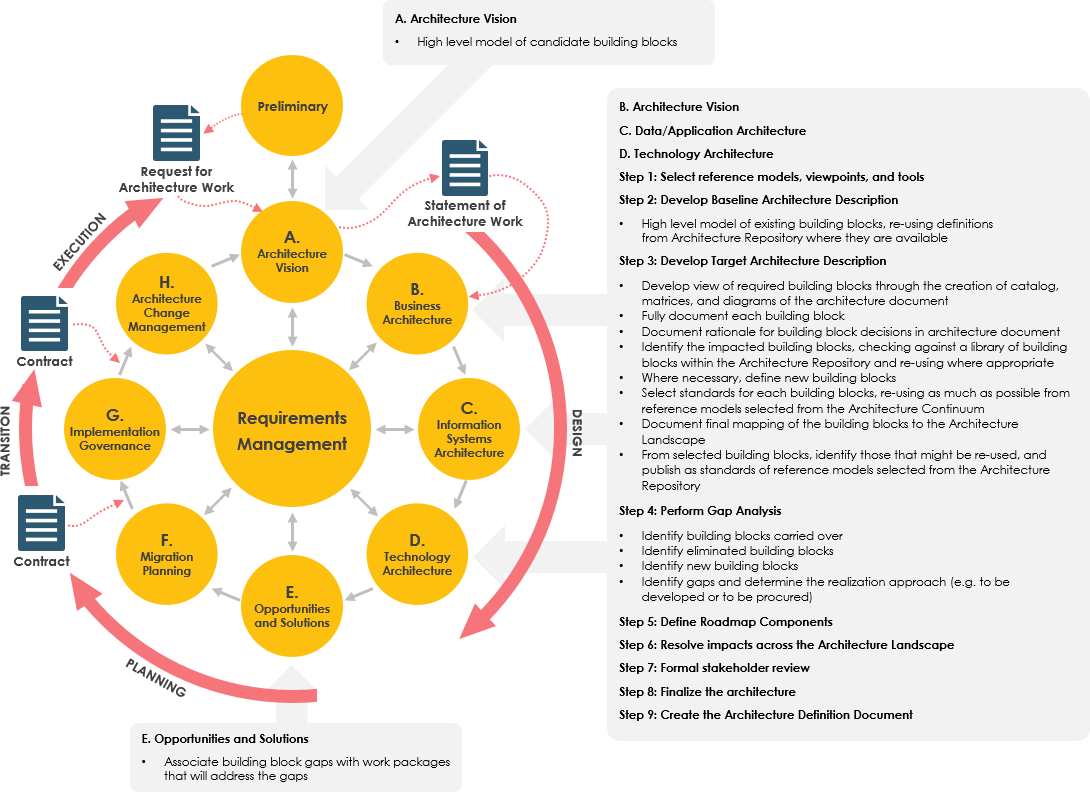TOGAF was developed starting 1995 by The Open Group, based on DoD’s TAFIM. As of 2016, The Open Group reports that TOGAF is employed by 80% of Global 50 companies and 60% of Fortune 500 companies.
What is TOGAF ADM?
The TOGAF ADM is the result of continuous contributions from a large number of architecture practitioners. It describes a method for developing an enterprise architecture, and forms the core of TOGAF. It integrates elements of TOGAF described in this document as well as other available architectural assets, to meet the business and IT needs of an organization. It is specifically designed to address enterprise’s business and IT needs by providing:
- A set of architecture views (business, data, applications, technology)
- Guidelines on tools for architecture development
- A set of recommended deliverables
- Linkages to practical case studies
- A Method for managing requirements
What are the Phases of the ADM?
The ADM consists of a number of phases that cycle through a range of architecture domains that enable the architect to ensure that a complex set of requirements is adequately addressed. The basic structure of the ADM is shown in Figure below:

The Architecture Development Method Cycle
The ADM is applied iteratively throughout the entire process, between phases, and within them. Throughout the ADM cycle, there should be frequent validation of results against the original requirements, both those for the whole ADM cycle, and those for the particular phase of the process. Such validation should reconsider scope, detail, schedules, and milestones. Each phase should consider assets produced from previous iterations of the process and external assets from the marketplace, such as other frameworks or models.
- The ADM supports the concept of iteration at three levels:
Cycling around the ADM: The ADM is presented in a circular manner indicating that the completion of one phase of architecture work directly feeds into subsequent phases of architecture work. - Iterating between phases: TOGAF describes the concept of iterating across phases (e.g., returning to Business Architecture on completion of Technology Architecture).
- Cycling around a single phase: TOGAF supports repeated execution of the activities within a single ADM phase as a technique for elaborating architectural content.
Summary of TOGAF ADM
| ADM Phase | Activity |
| Preliminary Phase: Framework & Principles | Prepare the organization for successful TOGAF architecture projects; define architecture principles; define framework and tools |
| Requirements Management | Ensure that every stage of a TOGAF project is based on and validates business requirements |
| Phase A: Architecture Vision | Set the scope, constraints, and expectations for a TOGAF project; create Vision; define stakeholders; validate the business context and create the Statement of Architecture Work; obtain approvals |
| Phase B: Business Architecture
Phase C: Information Systems Architectures Phase D: Technology Architecture |
Develop architectures at three levels:
In each case develop the Baseline (“as is”) and Target (“to be”) Architecture and analyze gaps |
| Phase E: Opportunities & Solutions | Evaluate and select among the implementation options identified in the target architectures; identify major implementation projects |
| Phase F: Migration Planning | Analyze cost benefits and risk; develop prioritized list of projects to form basis of implementation and migration plan |
| Phase G: Implementation Governance | Prepare and issue Architecture Contracts (Implementation Governance Board); ensure that the implementation project conforms to the architecture |
| Phase H: Architecture Change Management | Provide continual monitoring to ensure that the architecture responds to the needs of the enterprise |
Articles
- 1. Working with TOGAF ADM Guide-through
- 2. TOGAF ADM introduction
- 3. Preliminary Phase
- 4. Phase A – Architecture Vision
- 5. Phase B – Business Architecture
- 6. Phase C – Information Systems Architectures
- 7. Phase D – Technology Architecture
- 8. Phase E – Opportunities and Solutions
- 9. Phase F – Migration Planning
- Introduction to TOGAF ADM Phase F
- Implementation and Migration Plan
- Architecture Roadmap
- Architecture Requirements Specification
- Architecture Definition Document
- Implementation Governance Model
- Architecture Building Blocks
- Architecture Repository
- Architecture Contract with Business Users
- Architecture Contract with Development Partners
- Architecture Change Request
- 10. Phase G – Implementation Governance
- 11. Phase H – Architecture Change Management